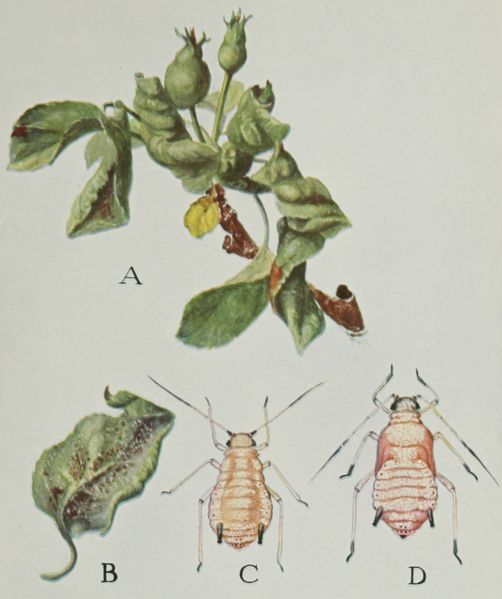Rosy Apple Aphid Threatens Apple Harvest: Expected 10-30% Reduction

Table of Contents
Understanding the Rosy Apple Aphid Infestation
The rosy apple aphid, aptly named for its distinctive pink coloration, is a particularly destructive pest of apple trees. These aphids feed on the sap of apple trees, causing a cascade of problems that significantly impact yield and fruit quality. Their feeding habits lead to several detrimental effects:
-
Leaf Curling and Distortion: Aphids suck sap from leaves, causing them to curl, distort, and become stunted. This significantly reduces the tree's photosynthetic capacity, limiting its ability to produce energy for growth and fruit development. Severe leaf curling can also lead to reduced overall tree vigor.
-
Honeydew Production: Their insatiable feeding produces copious amounts of a sticky substance called honeydew. This honeydew coats leaves and fruit, creating a sticky mess and providing a breeding ground for sooty mold. Sooty mold further reduces photosynthesis by blocking sunlight and impacting fruit marketability.
-
Transmission of Viruses: Rosy apple aphids can act as vectors, transmitting various plant viruses that can cause even more significant damage to the apple trees. These viruses can lead to stunted growth, reduced yields, and even tree death in severe cases. Early detection and control are crucial in preventing viral spread.
-
Reduced Fruit Size and Quality: Heavy infestations weaken the tree, leading to smaller, less marketable apples. The fruit may develop blemishes, exhibit poor coloration, and have a reduced storage life, impacting profitability for growers.
Identifying a Rosy Apple Aphid Infestation
Early detection is paramount for effective management of a rosy apple aphid infestation. Growers should regularly inspect their orchards for these telltale signs:
-
Pink or reddish aphids: Clusters of these tiny, pink or reddish aphids are typically found on the underside of leaves, particularly young, tender leaves.
-
Curled or distorted leaves: Significant leaf curling and distortion are clear indicators of a rosy apple aphid infestation. Look for leaves that are abnormally shaped or folded.
-
Presence of sticky honeydew: The presence of sticky honeydew on leaves and branches is a strong indicator. This sticky substance often glistens in the sunlight.
-
Sooty mold growth: The presence of black sooty mold growing on leaves and fruit is a secondary sign, but a clear indication of a significant aphid infestation.
Impact on Apple Production and Economic Losses
The predicted 10-30% reduction in apple yields due to rosy apple aphid infestations translates to substantial economic losses for growers. This impact ripples through the entire apple production and supply chain, affecting various stakeholders:
-
Reduced Farm Income: Lower yields directly and severely impact a grower's revenue, potentially jeopardizing the financial stability of the farm.
-
Increased Production Costs: Implementing management strategies, including insecticide applications and other control measures, significantly increases overall production costs, eating into profits.
-
Market Instability: Reduced supply due to widespread infestations can lead to price fluctuations and market instability, making it difficult for growers to plan and sell their produce effectively.
-
Consumer Impact: Ultimately, consumers may face higher prices or limited availability of apples due to reduced yields from widespread rosy apple aphid infestations.
Management Strategies for Rosy Apple Aphids
Several integrated pest management (IPM) strategies can effectively help control rosy apple aphid populations, minimizing the need for harmful pesticides:
-
Integrated Pest Management (IPM): This holistic approach combines various control methods for maximized efficacy while minimizing environmental impact. IPM relies on monitoring pest levels and implementing a range of strategies as needed.
-
Biological Control: Introducing natural predators like ladybugs, lacewings, and parasitic wasps can help regulate aphid populations naturally. These beneficial insects prey on aphids, keeping their numbers in check.
-
Cultural Control: Implementing cultural practices such as proper pruning to improve air circulation and sunlight penetration can discourage aphid infestations. Healthy trees are better able to withstand pest attacks.
-
Chemical Control: Insecticides should be considered a last resort and applied judiciously. Target specific aphid life stages and carefully follow label instructions. Always consider the impact on beneficial insects and the environment when choosing a pesticide.
Monitoring and Early Detection for Effective Control
Regular monitoring of apple orchards is critical for effective rosy apple aphid management. Implementing a proactive monitoring program is essential for early detection and timely intervention:
-
Regular visual inspections: Conduct thorough visual inspections of leaves and branches at regular intervals to identify early signs of infestation.
-
Sticky traps: Use sticky traps to monitor aphid populations and assess the effectiveness of control measures.
-
Scouting programs: Implement robust scouting programs to identify infestations early and initiate appropriate control measures before populations explode.
-
Collaboration with experts: Work with local agricultural extension services and entomologists for expert advice, updates on pest levels, and guidance on the most effective control strategies.
Conclusion
The rosy apple aphid presents a serious threat to apple production, with the potential for significant economic losses. Effective management requires a comprehensive, proactive approach combining careful monitoring, integrated pest management strategies, and timely intervention. By understanding the rosy apple aphid's life cycle, its impact on apple production, and available control methods, growers can minimize losses and protect their apple harvest. Don't let the rosy apple aphid ruin your harvest; take action now to protect your apple trees and ensure a bountiful yield. Learn more about effective rosy apple aphid control strategies and protect your crops today.

Featured Posts
-
 Diplome D Archiviste A Poitiers Apprenez Les Bases Du Metier
May 19, 2025
Diplome D Archiviste A Poitiers Apprenez Les Bases Du Metier
May 19, 2025 -
 Las Fuerzas Armadas Y El Cne Detalles De La Militarizacion De La Sesion
May 19, 2025
Las Fuerzas Armadas Y El Cne Detalles De La Militarizacion De La Sesion
May 19, 2025 -
 United Kingdom Eurovision Poll Bbc Radio 2s Top 21st Century Entry
May 19, 2025
United Kingdom Eurovision Poll Bbc Radio 2s Top 21st Century Entry
May 19, 2025 -
 Orlando Magic Vs Dallas Mavericks Game Preview Odds And How To Watch March 27th
May 19, 2025
Orlando Magic Vs Dallas Mavericks Game Preview Odds And How To Watch March 27th
May 19, 2025 -
 Chateau Diy Your Guide To Stunning Castle Inspired Projects
May 19, 2025
Chateau Diy Your Guide To Stunning Castle Inspired Projects
May 19, 2025
